New post on The Artist's Periscope
Donald Martiny: Gestures at Madison Gallery
by artperiscopeIn a world that is more and more removed and isolated, where finding contact and gesture and movement, both abstract and emotional, is increasingly difficult, Donald Martiny's expressively lyrical solo, Gestures, at Madison Gallery in La Jolla, California is refreshingly immediate.Alanic, 2014, Polymer and dispersed pigment on aluminum, 55 x 44 inchesOne is instantly struck by the work's visceral movement and vibrant color. But it would be too easy to reduce these forms to simply a discussion of color and flow. These enlarged brushlike strokes, formed from polymer and saturated pigment, are visual poems. They are the painterly equivalent of a verbal haiku, deceptively lean, but on reflection as complex as breath. The simplified structure allows the viewer to look deeper. The swaths of undulating paint, dotted with streaks of hidden color and seemingly random trace gesture, draw us closer, enticing us with their history. And the sensual , almost liquid quality of the forms woos us, like the touch of someones hand on bare skin, light but electric, the movement fleeting but the sensation enduring. The touch simple in form but resonant in understanding. That sensation is rare in this world of detachment. But as these paintings attest, and as has been said many times, "the simplest gesture is the most profound." It is indeed.Left: Togoyo, 2014, Polymer and dispersed pigment on aluminum, 68 x 43 inchesRight: Kore, 2015, Polymer and dispersed pigment on aluminum, 59 x 44 inchesTogoyo, 2014, Polymer and dispersed pigment on aluminum, 68 x 43 inchesKore, 2015, Polymer and dispersed pigment on aluminum, 59 x 44 inchesFrom left: Kott, 2015, Polymer and dispersed pigment on aluminum, 88 x 5 inchesOfo, 2015, Polymer and dispersed pigment on aluminum. 77 x 3 inchesWeyto, 2014 Polymer and dispersed pigment on aluminum. 91 x 46 inchesWeyto, 2014 Polymer and dispersed pigment on aluminum. 91 x 46 inchesNgbee, 2015, Polymer and dispersed pigment on aluminum. 44 x 90 inchesLaua, 2015, Polymer and dispersed pigment on aluminum, 76 x 77 inches
DONALD MARTINY
Monday, July 13, 2015
Tuesday, April 29, 2014
Donald Martiny
In the 1950s, artists like Jackson Pollock and Franz Kline elevated the gesture to the position of the protagonist in abstract expressionism. In the 21st century, Donald Martiny advances that idea considerably further by freeing the gesture of gestural abstraction from the substrate which, heretofore, provided the context that brought gesture to life. Working with polymers and dispersed pigments, Mr. Martiny has developed a methodology that enables him to isolate his sumptuous, almost sculptural, brushstrokes and lift them off the page, so to speak. The nature of his material is such that Mr. Martiny can work in a much larger scale than if he were dependent on a canvas surface; indeed, each singular brushstroke might range from two- to as much as six-feet in length. Installed, these compelling monochromatic gestures immediately breathe a new kind of life into the gallery space.
Historically, Mr. Martiny’s work to date fits right into the continuum of monochromatic painting, a contemporary reductive movement which has advanced the concerns and broadened the interests of the classic Minimalists of the 1960s and of the much earlier Suprematists, who openly sought the ‘death of painting” with their monochromatic efforts. Mr. Martiny, belongs to a family of painters which includes such luminaries as Kazimir Malevich, Alexander Rodchenko, Ad Reinhardt, Barnett Newman, Frank Stella, and Olivier Mossett. Quite amazingly, each of these distinguished artists brought something noticeably different to this admittedly singular and restrictive approach to painting. Prior to Mr. Martiny, though, each of these other great painters relied on manipulating the relationship between canvas and pigment to achieve subtle, nuanced differences in each painting. Mr. Martiny has greatly expanded the painterly agenda by taking the brushstroke completely off the canvas entirely. I applaud his commitment to furthering the monochromatic agenda and his ability to make fresh, new work that acknowledges, rather than negates, decades of previous good work. Rather than hastening the death of painting as Rodchenko forecast, monochromatic painting has already enjoyed a long life line and, in the hands of Donald Martiny, is clearly alive and well.
Charles A. Shepard III
President and CEO
Fort Wayne Museum of Art
Tuesday, April 15, 2014
Sunday, April 13, 2014
Monday, July 1, 2013
Studio Critical Interview Monday July 1, 2013
STUDIO CRITICAL
A behind the scenes approach to contemporary painting
Monday, July 1, 2013
DONALD MARTINY
Burnt Hills, 2012, 81 x 42.5",
polymers and dispersed pigment
What are you working on in your studio right now?
I recently received a commission to make paintings for the lobby of a new building in mid-town Manhattan by the Durst Organization. I am also preparing for a solo show of my work that will be in the lobby of the Conde Nast building at 4 West Times Square in New York from November 2013 to January 2014.
Can you describe your working routine?
I am usually in the studio between 8:30 and 9AM and work until around 7:30 PM. I work seven days a week. There is no set routine other than that. One day may be spent working on paintings, while the next day may be spent building shipping creates and ordering materials.
Can you describe your studio space and how, if at all, that affects your work?
I have had many different kinds of spaces. The large works that were exhibited last January at George Lawson Gallery, LA were all made on the cement floor of a converted tobacco factory in Durham. That space was extremely tight and challenging to move around in. I had a wonderful large space in Philadelphia when I lived there. I could leave things up on the wall to consider over a period of time. My current studio space is the main part of the house. It consists of two large rooms, an office and a workshop. The painting studio has an abundance of natural light and big double doors to move large works in and out. In the morning and evening hours I often see deer, eagles and owls. These natural surroundings provide a stimulus for my work. I am certainly affected and inspired by the movement, rhythm, time, changing light, color, and mood.
Installation at George Lawson Gallery, 2012
Tell me about your process, where things begin, how they evolve etc.
My process has evolved quite a bit. When I first considered the idea of working freely with forms in my paintings, I tried to use epoxy resins. I had experience working with fiberglass and resins from when I built boats as a summer job while I was in school near Lake Michigan. But the resins didn’t work. The paintings were prohibitively heavy and brittle and I couldn’t control the color. Additionally, the materials were hazardous. I nearly set my studio on fire once when I put too much catalyst (MEK) into the mixture. In terms of process, I draw and sketch all the time. I am constantly experimenting with gestures and forms, relationships and color. I usually make small paintings first. I think of them as finished paintings but they also inform the larger works. My large paintings are a huge investment in time, effort and materials. Some of them consist of 10 to15 gallons of paint. One part of my studio is set up much like an arena. I paint on the floor walking around the work. I often make brushes out of large floor mops or brooms. The act of painting is much like a dance. While creating a large painting, I am stretched to the limits of my physicality. The act of painting records my reach at a specific time and place. I suppose one could say in this way that my paintings are self-portraits.
Installation at Marlboro Gallery at Prince George Community College
What are you having the most trouble resolving?
I would like to spend more time making paintings and less time dealing with the business aspects of running a busy studio e.g., making schedules, shipping, building boxes, ordering materials, etc.
Do you experiment with different materials a lot or do you prefer to work within certain parameters?
I truly enjoy working with traditional oil painting methods but once my concept or idea of what a painting could be changed, my materials had to change too. I’ve spent several years talking with chemists all over the world and am on a first name basis with virtually every art materials manufacturer in trying to perfect my paint and process. I can finally say that I am happy with the materials I am using now. They are safe, odorless, water based, light-weight, and I can do just about anything I want in terms of painting. Because I mix micro bubbles into my paint I suppose one could say I am using nanotechnology in my painting process.
What does the future hold for this work?
The conceptual area I am working in opens up so many possibilities in painting. I haven’t even scratched the surface. I have numerous sketches and prototypes of new directions I am interested to explore. Each direction could keep me busy for years.
Pigeon Lake, 2012, 83 x 45",
polymers and dispersed pigment
Subscribe to:
Comments (Atom)

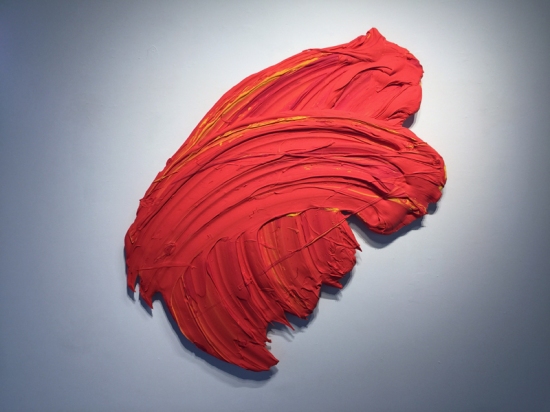
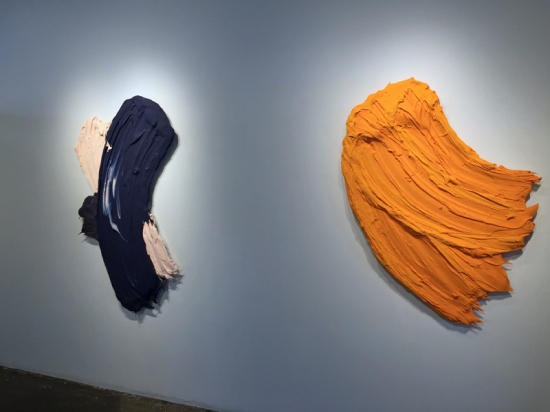
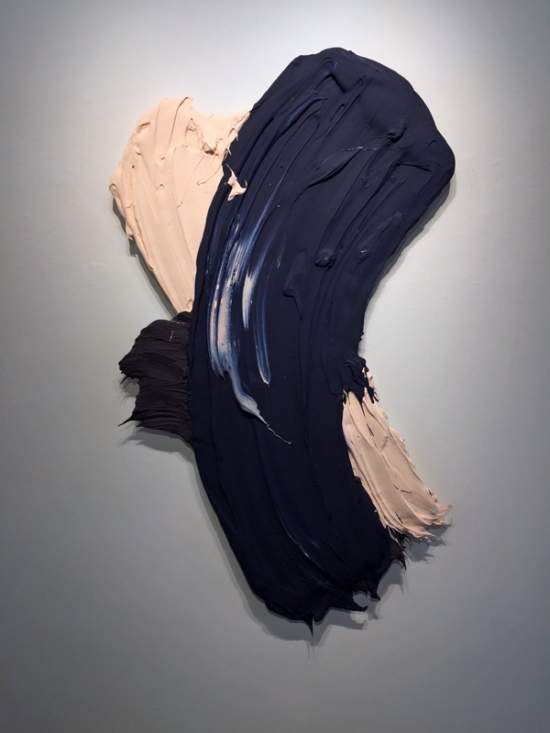
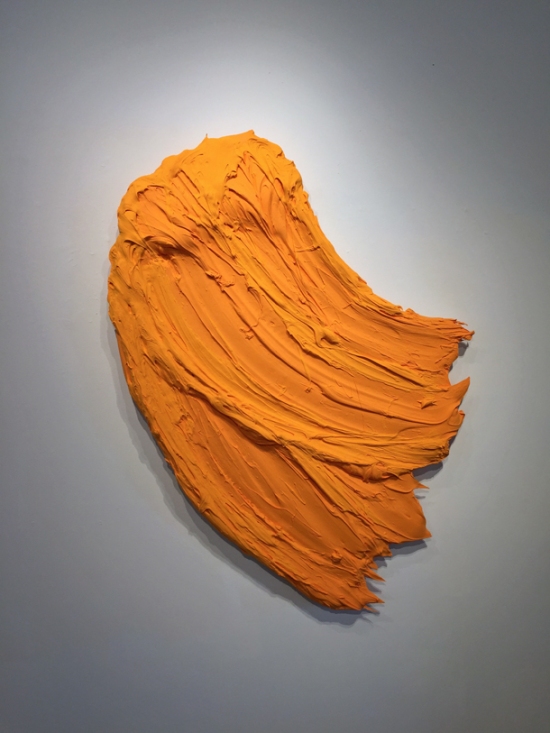
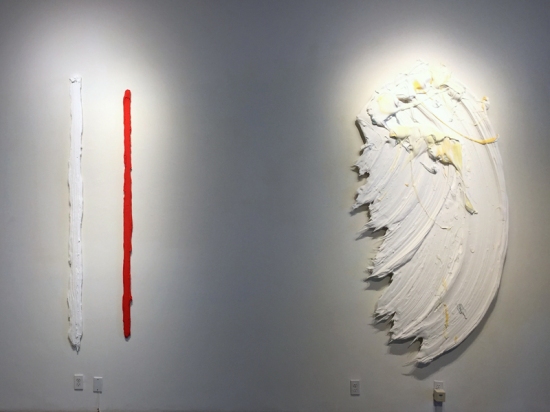
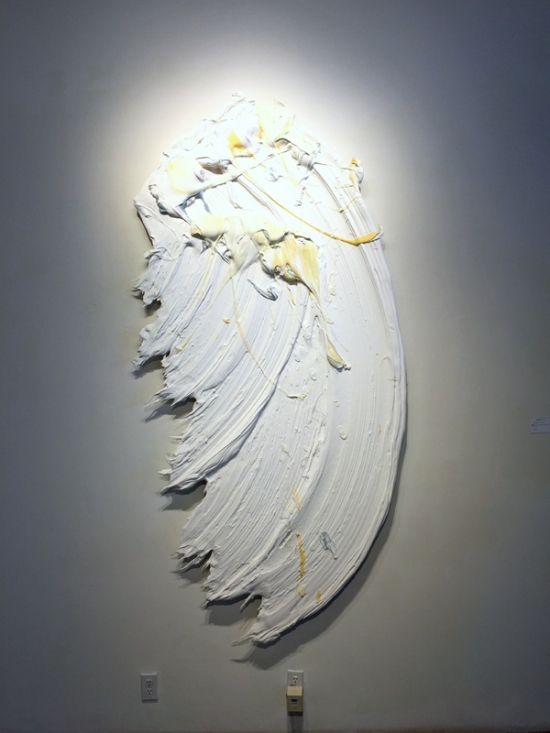
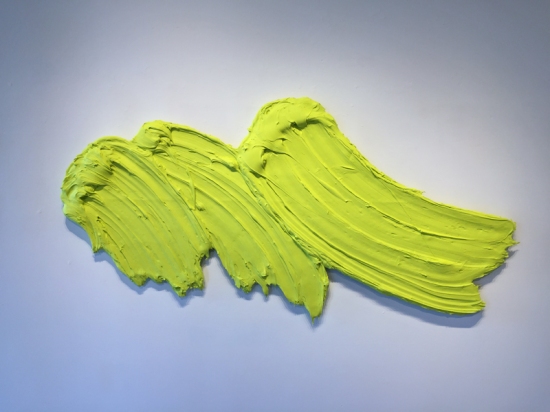
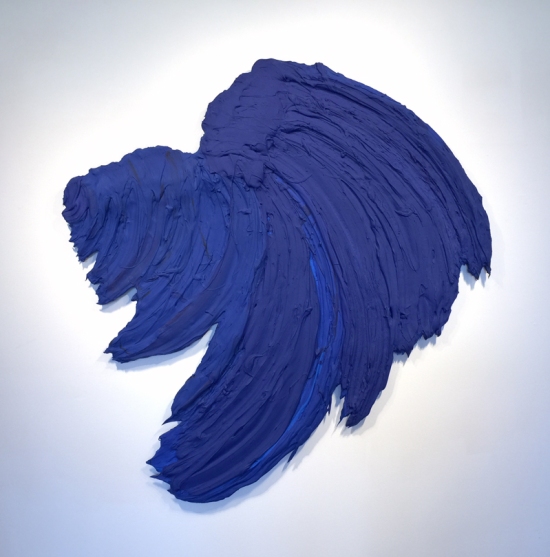
2014+45Hx31W.jpg)








